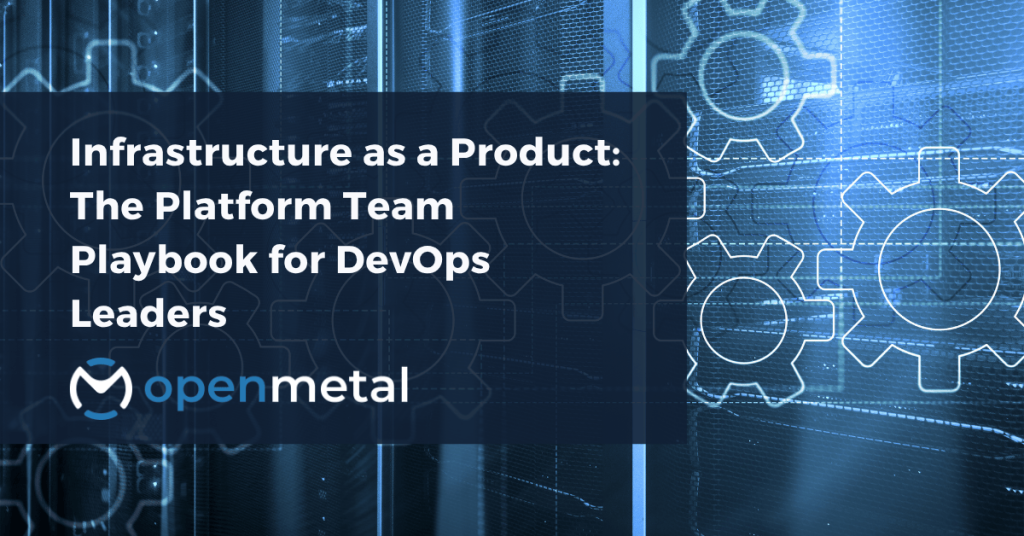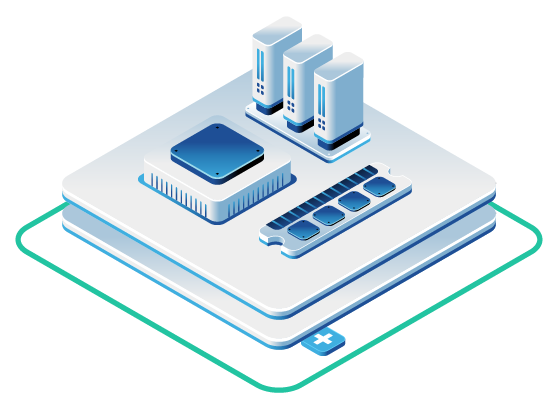
Ready to think of your infrastructure as an internal product?
The OpenMetal team is standing by to assist you with scoping out a fixed-cost model based infrastructure plan to fit your team’s requirements, budgets, and timelines.
The most challenging migration in enterprise IT isn’t moving from legacy infrastructure to private cloud—it’s moving from ticket queues to service catalogs, from gatekeepers to enablers, from IT operations to platform teams. Your developers don’t need another infrastructure refresh. They need infrastructure that feels like a product built for them.
This isn’t just about technology. The real transformation requires changing how IT thinks about its role in the organization. When IT functions as a bottleneck, developers create workarounds. When IT functions as a platform team, developers build faster, and the business moves with confidence.
Why Siloed IT Ops Doesn’t Work Anymore
Traditional IT operations grew up in an era where infrastructure changes happened quarterly, applications shipped annually, and developers submitted tickets to provision a virtual machine. That world no longer exists.
Today’s software teams expect to provision resources in minutes, not weeks. They’ve experienced the self-service model of public clouds, where APIs and automation replace approval workflows. When internal IT can’t match this velocity, developers find ways around it—spinning up shadow IT in public clouds, paying with corporate cards, and creating security nightmares that eventually land back on IT’s desk.
The silo structure makes this worse. In many organizations, networking sits in one team, storage in another, compute in a third. Each group has its own priorities, its own backlog, its own definition of success. A developer requesting a complete environment needs to coordinate across all these teams, waiting for each to complete their piece before moving forward. The delays compound. The frustration builds.
According to research from Team Topologies, organizations must design team structures that minimize dependencies and enable fast flow of value. When every request crosses multiple organizational boundaries, flow stops. When developers can’t get what they need internally, they go external.
The metrics tell part of the story. Industry research shows that 70% of developers spend three to four hours daily on tasks outside their core work when platform engineering is absent, and for 68% of organizations, the average time to deploy software to production stretches into weeks or months. Those numbers represent real business costs—not just in developer salaries, but in missed opportunities, delayed features, and competitive disadvantage.
But the deeper problem is cultural. Siloed IT operations treat infrastructure as something to protect and control. Platform teams treat infrastructure as something to productize and serve. That mindset shift determines whether your organization can move at the speed modern business demands.
The Rise of Platform Teams
Platform engineering isn’t new, but its recognition as a distinct discipline is. Gartner’s research notes that platform engineering has climbed rapidly in industry adoption, with internal developer portals emerging as a key enabling technology. The movement represents a fundamental rethinking of how IT delivers value.
Platform teams operate differently from traditional IT operations. Instead of responding to tickets, they build products. Instead of managing servers, they curate services. Instead of saying “no” to protect stability, they create guardrails that let developers say “yes” safely.
The platform itself becomes the product, and developers become the customers. This framing changes everything. Products have roadmaps driven by user needs. Products measure success by adoption and satisfaction. Products iterate based on feedback. When IT thinks this way, infrastructure transforms from a cost center into an accelerator.
Gartner emphasizes that platform engineering teams must improve developer experience, ensure consistent governance, and enable discovery and access to software development capabilities through self-service mechanisms. Internal developer portals serve as the interface to these capabilities, providing service catalogs, scaffolding templates, and automated workflows that abstract away infrastructure complexity without hiding it completely.
The platform team model also changes organizational structure. Team Topologies research shows that platform teams should provide compelling internal products that accelerate other teams. Rather than every team building its own deployment pipelines, monitoring systems, and security scanning tools, the platform team builds these once and makes them available to everyone. This reduces duplication, increases consistency, and frees application teams to focus on business logic rather than plumbing.
The benefits extend beyond velocity. When you productize infrastructure, you can version it, document it, and improve it systematically. You can measure how teams use different services and deprecate what’s not working. You can build feedback loops that surface developer pain points before they become organizational problems.
The Cultural Shift Is Harder Than the Technical Shift
Moving to OpenStack or Kubernetes is straightforward compared to changing how people work. Technology migrations have clear milestones: clusters deployed, workloads migrated, old systems decommissioned. Cultural transformations have no such clarity.
The challenge starts with identity. Infrastructure teams built their expertise around specific technologies and processes. They became the experts who knew how to configure that particular storage array or tune that specific hypervisor. When you move to a platform model, that expertise matters less than the ability to expose capabilities through APIs and maintain service level objectives.
This shift can feel threatening. Senior engineers who spent years mastering traditional infrastructure may resist becoming “just” the operators of someone else’s platform. They need to see that platform engineering isn’t a demotion—it’s a different kind of mastery. Building reliable self-service infrastructure that thousands of developers depend on requires deep technical skill combined with product thinking.
The organizational friction goes deeper. Traditional IT operations often measure success by uptime and ticket closure rates. Platform teams measure success by developer productivity and time-to-production. These metrics point in fundamentally different directions. Maximizing uptime might mean restricting changes. Maximizing productivity might mean enabling rapid experimentation.
Finance teams struggle with this too. The old model had clear line items: server purchases, software licenses, support contracts. Platform engineering spreads costs across shared services where attribution gets murky. How do you charge back for a CI/CD pipeline or a monitoring stack that serves dozens of teams? The accounting doesn’t map cleanly to traditional IT budgeting.
Then there’s the change in power dynamics. In siloed operations, IT controls access to infrastructure. Developers request, IT approves. Platform teams flip this relationship. Developers provision what they need within guardrails the platform team establishes. IT’s power shifts from gatekeeping to governance—from saying who can have infrastructure to defining how infrastructure should be used.
This transformation requires executive support that goes beyond budget approval. Leaders must communicate why the change matters, what success looks like, and how individuals’ roles will evolve. They must accept that the transition will be messy, that some experiments will fail, and that learning will take time.
The hardest conversations happen around accountability. When something breaks in traditional IT, you know which team to blame. When it breaks in a platform model, responsibility gets distributed. Did the platform fail? Did the developer misconfigure something? Did the guardrails fail to catch a problem? These questions require collaboration rather than finger-pointing, and many organizations struggle to build that muscle.
Private Cloud as a Platform Backbone
Public clouds succeeded by treating infrastructure as an API-accessible service rather than a collection of hardware. Private clouds can deliver the same experience when organizations adopt the same mindset.
The technology exists. OpenStack provides the control plane that turns bare metal into programmable infrastructure. Kubernetes orchestrates containerized workloads at scale. Terraform and similar tools enable infrastructure as code. But having these technologies doesn’t mean having a platform. A platform requires intentional design around developer workflows.
This is where many private cloud initiatives stumble. Organizations migrate from VMware to OpenStack and celebrate the technical achievement while developers still submit tickets for access. The underlying virtualization technology changed, but the operating model stayed the same. The result? All the complexity of private cloud with none of the developer experience benefits.
A true platform approach starts with understanding what developers need: environments that spin up on demand, secrets management that doesn’t require emailing credentials, networking that just works, and storage that scales without procurement cycles. Then you build services that deliver those outcomes through self-service interfaces.
The API-first principle becomes non-negotiable. If developers can’t provision infrastructure programmatically, you haven’t built a platform—you’ve built infrastructure that still requires human coordination. APIs enable automation, which enables consistency, which enables the velocity that makes platform engineering worthwhile.
Security and governance must be built into the platform, not bolted on afterward. When developers provision resources through the platform, those resources should automatically include logging, monitoring, backup, and compliance controls. This “shift left” approach distributes security responsibility while maintaining organizational standards.
The private cloud foundation also needs to support experimentation. Developers should be able to create sandbox environments without affecting production, test new configurations without lengthy approval processes, and fail safely without career consequences. Learning requires trying things that might not work. Platform teams create the guardrails that make safe experimentation possible.
Cost visibility becomes part of the platform too. When infrastructure is opaque, developers have no incentive to optimize. When the platform shows real-time cost attribution, teams can make informed tradeoffs between performance and budget. Transparency drives better decisions.
OpenMetal’s Perspective
At OpenMetal, we have witnessed how enterprises stumble when they continue to manage private cloud environments as static infrastructure projects. The failure comes from treating the private cloud like a collection of hardware rather than as a living, evolving platform. In many organizations, IT becomes the bottleneck when it remains siloed, and developers end up frustrated with extended wait times, inconsistent access, or shadow IT services spun up outside official processes.
What is needed instead is a mindset shift: private clouds must be productized, with APIs, self-service tools, and curated services designed to serve the internal developer and data science community.
OpenMetal’s hosted private cloud powered by OpenStack gives organizations a way to adopt this platform mindset without having to build everything themselves. Each customer receives a dedicated OpenStack environment that can be treated as an internal developer platform. This allows software and data teams to provision resources on-demand while IT retains full governance, security, and cost predictability.
By shifting from infrastructure as a project to infrastructure as a product, enterprises can meet developer expectations for speed and flexibility without sacrificing oversight.
Unlike hyperscalers, OpenMetal’s model delivers both full administrative access and open-source flexibility. Customers are not locked into proprietary ecosystems or burdened by unpredictable licensing costs. Instead, they gain a transparent, fixed-cost infrastructure foundation that makes it easier to expose APIs, service catalogs, and other self-service capabilities internally. This creates a beneficial cycle: IT can focus on enabling internal users, while developers experience the autonomy they need to move quickly.
For organizations shifting from legacy environments, the realization often comes quickly that the technical migration is only half the battle. The harder challenge is rethinking how IT functions at its core. Moving to a new platform exposes fundamental questions: is IT simply the caretaker of servers, or is it the provider of services and experiences?
With OpenMetal’s approach, platform teams can deliver fully functional private clouds in hours rather than months. This speed enables them to iterate, experiment, and align their services with what developers and business stakeholders actually need. Instead of firefighting infrastructure bottlenecks, IT can evolve into a platform team that actively accelerates business outcomes.
Unique Viewpoint
The conversation around platform engineering often focuses on tooling: which portal to implement, which orchestration system to deploy, which cloud to build on. But tools are the easy part. The transformation that matters happens in how IT defines its mission.
Traditional IT sees its job as keeping systems running. Platform teams see their job as making developers productive. That distinction drives every decision: how you prioritize work, how you measure success, how you interact with other teams, and how you allocate resources.
This mission change also affects hiring and skills development. Platform teams need people who can code, understand distributed systems, and empathize with developer workflows. They need product managers who can translate developer needs into platform features. They need designers who can make self-service portals actually usable. The skillset looks more like a product development team than a traditional operations team.
The organizational positioning matters too. Platform teams need sufficient autonomy to make technology decisions quickly, but enough alignment with the business to prioritize work that delivers value. They sit between infrastructure and application teams, serving both while belonging fully to neither. This can create political challenges that require executive air cover.
What makes platform engineering work is treating it as a continuous practice rather than a one-time project. You don’t “complete” the transition to platform teams. You iterate on the platform, evolve the services, gather feedback, and improve. The moment you declare victory and stop investing, the platform stagnates and developers start looking elsewhere again.
The most successful platform teams we’ve observed share a common characteristic: they obsess over developer experience the way product teams obsess over customer experience. They measure developer satisfaction. They conduct user research to understand pain points. They A/B test different approaches to self-service workflows. They think about onboarding, documentation, and support as core platform capabilities, not afterthoughts.
This developer-centric approach extends to how platform teams communicate. They maintain transparent roadmaps, explain why certain decisions were made, and create channels for feedback. When developers feel heard and see their input reflected in platform improvements, adoption follows naturally.
The economics shift too. Platform teams reduce total cost of ownership not by buying cheaper hardware, but by eliminating duplication and increasing efficiency. When every team maintains its own deployment pipeline, the organization pays that cost repeatedly. When the platform team builds a shared pipeline that everyone uses, the cost is paid once. The same logic applies to monitoring, logging, secrets management, and dozens of other capabilities.
But the real value comes from velocity. When developers spend less time fighting infrastructure and more time building features, the business moves faster. When infrastructure provisions in minutes instead of weeks, time-to-market shrinks. When experimentation becomes cheap and safe, innovation increases. These benefits are harder to quantify than hardware costs, but they determine competitive position.
Market Relevancy
The VMware Catalyst: Why Broadcom’s Acquisition Accelerated a Transformation Already Underway
The technology industry’s attention focused sharply on platform engineering and private cloud alternatives following Broadcom’s 2023 acquisition of VMware. The acquisition brought sweeping licensing changes, including the elimination of perpetual licenses in favor of subscription-based models and a shift from per-socket to per-core pricing. Many customers reported cost increases ranging from three to six times their previous spending, with some organizations experiencing up to 450% increases in support costs.
The disruption proved especially challenging for small and medium enterprises. With over 75% of some cloud service providers’ revenues tied to VMware’s virtualization technologies, the inability to license VMware software under previous terms created substantial business challenges. Broadcom also discontinued many products without notice and rebundled others under new contracts, forcing customers to reevaluate their entire infrastructure strategy.
But the VMware situation is a symptom, not the cause, of the broader platform engineering movement. Organizations were already struggling with siloed IT operations, frustrated developers, and the cultural gap between traditional infrastructure management and modern development practices. The Broadcom licensing changes simply made the status quo financially untenable for many companies, accelerating conversations that should have happened years ago.
The real story is that enterprises are fundamentally rethinking how they deliver infrastructure. Gartner predicts that by 2026, 75% of organizations with platform engineering teams will provide internal developer portals, up from 45% in 2023. This growth trajectory started before the VMware acquisition and will continue long after the licensing dust settles.
Organizations exploring alternatives to VMware find themselves confronting the same core questions: How do we make our developers more productive? How do we maintain governance without creating bottlenecks? How do we build infrastructure that feels like a product rather than a cost center? The answers to these questions require platform thinking, whether the underlying technology is OpenStack, Kubernetes, or something else entirely.
The VMware disruption created urgency, but the transformation toward platform teams and internal developer platforms represents a long-term shift in how enterprises operate. The organizations that emerge strongest won’t be those that simply switched hypervisors—they’ll be those that used the disruption as an opportunity to fundamentally reimagine how IT serves the business.
Conclusion
The migration from traditional IT operations to platform teams represents one of the most significant organizational transformations in enterprise technology. It’s not about implementing new tools or migrating to new infrastructure. It’s about fundamentally changing how IT creates value.
Platform teams succeed when they make developers more productive, reduce time-to-market, and enable safe experimentation at scale. They fail when they focus solely on technology without addressing culture, or when they build platforms for how developers should work rather than how developers actually work.
The technical foundation matters—whether that’s OpenStack, Kubernetes, or hybrid approaches that combine multiple technologies. But the foundation only enables the transformation. The real work happens in changing how teams collaborate, how organizations measure success, and how IT defines its mission.
For VPs of Infrastructure and DevOps leaders navigating this transition, the path forward requires balancing technical decisions with cultural evolution. You need executive support to make organizational changes stick. You need investment in new skills and capabilities. You need the patience to iterate and learn rather than expecting immediate perfection.
But most importantly, you need to shift the conversation from “how do we manage infrastructure” to “how do we serve our developers.” When that question drives your decisions, platform teams emerge naturally. When IT becomes an internal cloud service provider rather than a gatekeeper, the entire organization accelerates.
The future of enterprise infrastructure isn’t just private cloud or public cloud or hybrid cloud. It’s infrastructure delivered as a product, with APIs, service catalogs, and developer experiences that enable rather than constrain. Organizations that embrace platform thinking will move faster, innovate more readily, and compete more successfully. Those that don’t will find their best developers looking for environments where they can.
Your platform team transformation starts with infrastructure that thinks like a product. OpenMetal provides dedicated private clouds with complete administrative control and transparent pricing—giving you the foundation to build self-service experiences developers actually want.
Read More Blog Posts
Works Cited
Bhat, Manjunath, et al. “Market Guide for Internal Developer Portals.” Gartner, 2023, www.gartner.com/en/documents/6306515.
“Broadcom VMware Licensing Changes Explained.” Redress Compliance, 27 Dec. 2023, redresscompliance.com/broadcom-vmware-licensing-and-subscription-changes-explained/.
“Impact Of Broadcom’s Acquisition Of VMware On Licensing & Alternatives.” TeckPath, 14 Oct. 2024, teckpath.com/the-aftermath-of-broadcoms-vmware-acquisition-licensing-struggles-and-alternatives-for-it-service-providers/.
Skelton, Matthew, and Manuel Pais. Team Topologies: Organizing for Fast Flow of Value. Team Topologies, teamtopologies.com/.
“The 2024 State of Internal Developer Portal Report.” Port, 18 June 2025, www.port.io/blog/the-2024-state-of-internal-developer-portal-report.


































